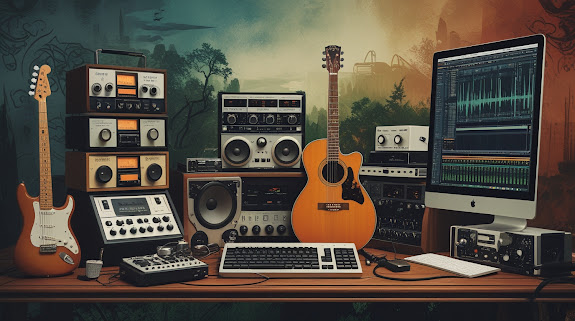The Evolution of My Sound: A Journey Through 30 CDs
The Early Years: Experimentation and Inspiration
It all began when I was 15, armed with an electric guitar and amp. Those first compositions were, admittedly, rough around the edges, but they marked the beginning of a lifelong passion. My initial guitar teacher didn't quite spark the fire I was looking for, but I soon found another who opened my eyes to the endless possibilities of music. This newfound inspiration propelled me into forming a band just a few months after picking up the instrument.
Those early days were filled with creativity and experimentation. I remember setting up three ghetto blasters in my garage to record my music. One would play back the rhythm while I recorded the main solo on another, and a third would capture the harmony. It was a crude but effective method that allowed me to layer my sound. Of course, this setup often led to complaints from the neighbors across the street, who weren't too fond of my loud garage sessions!
The Advent of Home Recording
A significant turning point came when I borrowed a Fostex 4-track recorder. Despite its limitations—running in mono and only having three functional tracks—it allowed me to capture my ideas more effectively. I used a keyboard to simulate drum parts, which was a crucial step in developing my home recording skills.
As technology improved, so did my equipment. I upgraded to newer 4-track recorders, then moved on to 8 and 16 tracks. Eventually, I transitioned to using a computer with Steinberg Cubase as my digital audio workstation (DAW). This shift opened up a world of possibilities, enabling me to record and manipulate my music with greater precision.
Modern Techniques and Collaborations
Today, I can record my electric and acoustic guitars directly into the computer, bypassing traditional amps. This allows me to maintain the integrity of my performances while experimenting with different tones. I've also incorporated professionally recorded drum loops into my compositions, which has streamlined the process of building songs and adding depth to my music.
Over the years, I've had the privilege of collaborating with a variety of talented musicians, including drummers and pianists/keyboardists. While I often handle most of the instrumentation myself—playing guitars, bass, banjo, mandolin, ukulele, keyboards, percussion, and more—I appreciate the richness that guest musicians bring to my work.
The Fusion of Styles
My music is a fusion of diverse styles, blending elements of rock, blues, new age, Celtic, bluegrass, classical, folk, and more. At times, my compositions can evoke the cinematic feel of movie or TV score tracks. This eclectic approach allows me to explore different emotional landscapes and create music that resonates with listeners on multiple levels.
Reflections and Future Directions
Looking back on thirty albums, I am proud of the journey my music has taken. From those early garage sessions to the sophisticated productions of today, each step has been a learning experience that has shaped my sound. As I continue to compose and record, I am excited to see where this evolution will take me next. The fusion of technology and creativity has opened endless doors, and I look forward to exploring new sounds and styles in the years to come.
#IndieMusic #IndieArtist #Musician #Guitarist #InstrumentalMusic #NewAgeMusic #CelticMusic #BluegrassMusic #FolkMusic #MusicProduction #HomeRecording #DIYMusician #IndependentArtist #UnsignedArtist #MusicDiscovery #MusicLovers #GuitarMusic #InstrumentalGuitar #Rock #Blues #Classical


